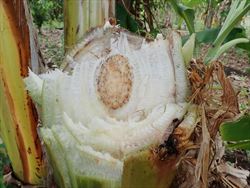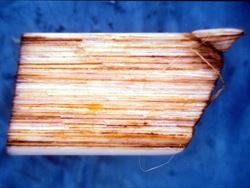Blood disease. It is also known as blood disease bacterium of banana.
Pacific Pests, Pathogens, Weeds & Pesticides - Online edition
Pacific Pests, Pathogens, Weeds & Pesticides
Banana blood disease (522)
Ralstonia syzygii subsp. celebesensis; previously, it was known as Pseudomonas celebesensis, Pseudomonas sp. nr. solanacearum. There is similarity to Ralstonia solanaciarum (moko and bugtok), although the blood disease bacterium is considered to be of different origin. In a new classification system based on molecular analysis, Ralstonia syzygii is in Phylotype IV (Indonesian) on origin and evolution. The abbreviation is BDB.
Asia (Indonesia, Malaysia). Blood disease is recorded across Indonesia from North Sumatra to West Irian, and on the Malaysian peninsular. It was reported from Irian Jaya in 2001, and is now in most Indonesian provinces on the island of New Guinea. It is not recorded from Papua New Guinea or elsewhere in Pacific island countries.
Banana. Many varieties of Musa acuminata and Musa balbisiana are susceptible as well as hybrids between them. Musa textalis is also a host. However, wild hosts are not well known, and neither is it known if species related to Musa (e.g., Heliconia, Strelitzia, Ravenala), are hosts.
A bacterium causes the damage by invading the water-conducting tissues and blocking them. Symptoms differ depending where the infection originates.
When infections starts from the soil, especially on young plants before fruiting, leaves turn yellow, wilt (the leaf stalks collapse and leaf blades hang down around the stem), and plants die (Photo 1). Internally, stems show reddish-brown vascular staining (Photo 2). Bacterial ooze of varying colours - white, yellow, red or black - discharges from the vascular tissues (hence the association with 'blood').
When infection starts from the flowers, the bacteria make their way into the central fruit stem. The flowers turn black, and the male 'bell' rots, and fruit, if present, may look healthy from the outside, but when cut open show red-brown rots within (Photos 3-4). Staining of the vascular tissues of the fruit stalk continues (Photos 5&6), reaching the corm and then into the pseudostem (overlapping leaf sheaths), but often concentrated in the centre (Photo 2). Leaves then turn brown, wilt and die.
The bacterium is not always present throughout the plant and suckers detached from mother plants may be healthy.
Spread occurs over short distances in infected suckers, in soil, water and by root-to-root contact between diseased and healthy plants; insects, too, spread the disease as they visit flowers to collect pollen. Infection via female flowers seems possible too from recent studies. Spread by human beings occurs in a number of ways: tools, especially knives, used in propagation carry the bacterium and long-distance spread occurs in contaminated suckers. Infected fruit have also been implicated in spread, as it is impossible to tell if they are infected, but if purchased and found to be diseased they are likely to be discarded without proper care. The bacterium survives in soil and plant remains for over a year, and contaminated soil is a major source of infection.
Studies on the development of blood disease, and other bacterial diseases of banana, i.e., moko (South and Central America), xanthomonas wilt (Africa), and bugtok (the Philippines), have highlighted their similar epidemiology (see Fact Sheet nos. 523, 524, 525). Of interest is the role of insects in spreading these diseases, and the reason why ABB/BBB cooking bananas show greater susceptibility.
In the field, insects - bees, flies, wasps - are attracted to male flowers, possibly because of the high sugar content of their nectar, and its accessibility. As the male flowers and leaf-like 'bracts' they cover fall off, they leave scars which oozes liquid for several weeks, and this attracts insects. The interaction between insects, ooze and bacterium is crucial to the development of blood (and similar) disease.
Blood disease was first recorded in South Sulawesi, Indonesia, in 1905; it was so serious that many growers abandoned production. It remained there for about 60 years before spreading to other islands, and to adjacent Malaysia where it is present with moko and Fusarium wilt diseases of banana. CABI records several occasions when the disease has caused losses in recent years (often exceeding 35%), especially in popular ABB* types. However, details regarding the economic and social consequences to either subsistence or commercial bananas are not well documented. It is also likely that the disease will cause a shift in varieties grown, and perhaps loss of genetic resources. It has already been seen that where the disease is epidemic, the favoured variety, Pisang Kepok, preferred for its sweet edible 'bell' or male flowers, is being devastated, and it is likely that other varieties that shed male bracts and flowers will suffer a similar fate.
Look for yellow leaves that collapse around the stem, reddish-brown vascular tissues in leaf sheaths, stems of fruit, and internal rots of fruits while still green. CABI provides methods of isolation and diagnosis to allow differentiation of blood disease from moko and bugtok caused by strains of Ralstonia solanacearum. There are also published methods of inoculation to prove pathogenicity. Unlike moko, bacteria from blood disease do not infect capsicum, tobacco, or tomato.
Symptoms of blood disease have been confused with those of banana xanthomonas wilt in East Africa (caused by Xanthosomonas campestris pv. musacearum), so it is best to confirm using antigen and molecular tests (ELISA and PCR) to differentiate between this diseases, and between them and moko/bugtok.
BIOSECURITY
Attempts to limit the spread of the disease to South Sulawesi were successful lnitially, but after 60 years it eventually spread, and was recorded in West Java in 1987. Since then, it has spread and is now in most of the larger islands of Indonesian including West Papua (Irian Jaya), threatening Papua New Guinea. It has also spread to peninsular Malaysia, making it likely that it will reach other countries in Asia, and possibly South East Africa. Quarantines to prevent unofficial introduction of the disease to vulnerable islands (especially within Indonesia) and other countries are clearly required.
Where official transfers of banana, including its wild hosts, are required, these should follow the FAO/IBPGR Technical Guidelines for the Safe Movement of Germplasm. No. 15. Musa. 2nd Edition, (http://www.bioversityinternational.org/uploads/tx_news/Musa_spp.__2nd_edition__502.pdf). These state that germplasm should be transferred as virus-indexed plantlets growing in a sterile tissue culture medium.
CULTURAL CONTROL
Techniques are similar to those developed for control of banana xanthomonas wilt in Africa (see Fact Sheet no. 523) and those used with success against bugtok in the Philippines (see Fact Sheet no. 524). The main thrust, is directed at smallholder growing popular but susceptible plantains, ABB/BBB groups. Blood disease is much less in commercial plantations of AAA Cavendish where regular monitoring, fruit bagging and removal of the male bell, is practised.
Before planting:
- Use only disease-free planting material; never plant cuttings, (i) from plants that you have not monitored, especially from neighbours, markets, unknown sources; and (ii) never plant suckers from an infected plant. If unsure of the disease status, create a nursery and monitor plants in isolation from the main production areas.
- Ideally, start plantings with government stock, if there is a banana disease certification scheme locally.
- Do not plant near plots that have the disease; above all, do not plant suckers down-wind from diseased plants.
During growth:
- Exclusion:
- Bag the inflorescence after emergence with polyethylene, muslin, nylon or mesh bags. These can be taken off after fruit set if the male buds are also removed.
- Remove weeds; Ralstonia bacteria have a wide host range.
- Limit access of animals, workers, visitors (including middlemen), vehicles into banana fields. Middlemen should not be allowed to harvest bananas as their risk of spreading the disease as they travel from farm to farm is high
- Pruning:
- Remove male buds (bell) immediately after the last hand emerges. Ideally, a forked stick is used, rather than farm tools.
- Hygiene:
- Clean tools (especially knives used for de-suckering, removing/chopping diseased plants) and machinery with bleach (dilute one part household bleach with three parts water), clean soil from footwear
- Monitor/Treat:
- Check farms frequently for symptoms of blood disease and, where found, remove diseased plants, and their immediate neighbours. Do the following:
- Kill diseased plants (with herbicides if resources allow, or chop them with machetes), including suckers. When dry, burn the plants, including infected fruits, on site.
- Dig a trench around diseased plants to retain run-off rain water. Sites should be left fallow for 18 months without weeds or planted to a cover crop, such as Mucuna.
- Check farms frequently for symptoms of blood disease and, where found, remove diseased plants, and their immediate neighbours. Do the following:
After harvest:
- Carry on monitoring and treating plants if symptoms are seen. If it proves impossible to continue to grow susceptible ABB/BBB varieties, change to others which are less susceptible (see below).
RESISTENT VARIETIES
Although most varieties are susceptible to blood disease in inoculation tests, there are differences under farmer field conditions, Surveys in Indonesia in the 1990s, for instance, showed that blood disease mostly affected balbisiana (ABB or BBB) cooking varieties. Insects spreading the bacterium are likely influenced by differences in the sweetness of nectar between varieties. If practical, replace especially susceptible varieties (e.g., Pisang Kepok in Indonesia, Saba in the Philippines), with less-susceptible varieties. In Indonesia, Piang Puju is one such variety that can be used. It is an ABB cooking banana from Sulawesi that aborts the male bell (i.e., it is a bell-less mutant), reducing the chance of bacterial transmission by insects. Others varieties with potential are Pisang Susu (AAB), Pisang Mas (AA), and Pisang Raja (AAB), although they are less preferred in many parts of the country than Pisang Kepok.
CHEMICAL CONTROL
Not a method to use for the control of this disease.
AUTHOR Grahame Jackson
Information from Drenth A, Kema G (2021) The vulnerability of bananas to globally energing disease threrats. Phytopathology 111: 2146-2161; and Blood disease (2018) NSW Department of Primary Industries. NSW Government; Eden-Green SJ (1994) Musa Disease Fact Sheet no. 3. International Network for the Improvement of Banana and Plantain, Parc Scientifique Agropolis, 34397 Montpellier Cedex 5, France; and Blomme G, et al. (2017) Bacterial diseases of banana and enset: Current state of knowledge and integrated approaches toward sustainable management. Frontiers in Plant Science. (https://www.frontiersin.org/articles/10.3389/fpls.2017.01290/full#B66); and Davis RI, et al. (2001) Blood disease and panama disease: two newly introduced and grave threats to banana production on the island of New Guinea. In: Proceedings of the Papua New Guinea Food and Nutrition 2000 Conference, PNG University of Technology, Lae, 26–30 June 2000. ACIAR Proceedings No. 99, xviii + 892p.; and CABI (2019) Blood disease bacterium (blood disease bacterium of banana. Crop Protection Compendium. (https://www.cabi.org/cpc/datasheet/46702); and FreshPlaza. Banana blood disease poised to spread throughout Southeast Asia. (https://www.freshplaza.com/article/9384862/banana-blood-disease-poised-to-spread-throughout-southeast-asia/); and Ray JD, (2021) Geographic expansion of banana blood disease in southeast Asia. Plant Disease. The American Phytopathological Society. (https://apsjournals.apsnet.org/doi/10.1094/PDIS-01-21-0149-RE); and from Drenth A (2020) Reversing the impact of Banana blood disease in Indonesia. APBSF Project Final Report PBSF016: 22pp. (http://www.apbsf.org.au/wp-content/uploads/2020/06/PBSF016-Drenth-Banana-Blood-Disease-Final-Report.pdf). Photos 1-5 Jane Ray, Centre for Horticultural Science, The University of Queensland, Brisbane, QLD 4001, Australia. Photo 6 Davis RI, Liberato JR (2006) Banana blood disease (Blood disease bacterium). PaDIL - http://www.padil.gov.au.
Produced with support from the Australian Centre for International Agricultural Research under project HORT/2016/185: Responding to emerging pest and disease threats to horticulture in the Pacific islands, implemented by the University of Queensland, in association with the Pacific Community.
*The codes ABB and BBB are determined by the proportion of Musa acuninata and Musa bulbisiana (original species) represented in any variety. An internationally recognised scoring system is used to determine the proportion.









